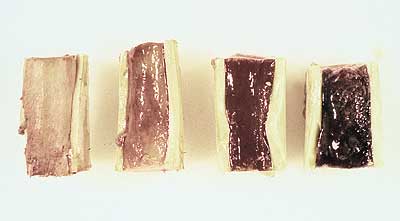Parasites and Diseases
Starvation/Malnutrition
A Field Guide
TO COMMON WILDLIFE DISEASES
AND PARASITES IN ALASKA
STARVATION/MALNUTRITION

Sections of leg bones from caribou, with gradually depleted fat from left to right.
| What causes starvation-malnutrition? |
- Starvation occurs when an animal is not able to get the amount of energy or nutrients from food that it needs.
- There may not be enough food available, or the animal may not be able to reach or get nutrients from food because of environmental factors (deep snow or a hard crust) or physical problems (injury, disease, parasites, poor teeth).
| When does starvation-malnutrition occur? |
- Starvation and malnutrition can affect any wildlife species and usually affects young, old, weak, or sick animals.
- It usually occurs in winter.
| What are the signs of starvation-malnutrition? |
- Animals may be weak with not much body fat.
- The skin may appear loose with a dull, rough hair coat.
- Animals may have humped or sagging backs, sunken eyes, and small tucked up bellies.
- The bones of the shoulders, ribs, back and hind end may stick out.
- When butchering, you may notice a lack of fat under the skin, around the heart, kidneys and other organs, and in the bone marrow (e.g., thigh bone).
- The marrow of a starving animal may be a red or yellow, jelly-like liquid. Bone marrow from a healthy animal is usually solid, white and waxy.
- Muscles and organs such as the liver may have shrivelled.
- The intestines and stomach may not contain much food or may be full of dry, poor quality food.
| Can I eat the meat? |
- Meat from infected animals is suitable for human consumption.
- Starvation and malnutrition may decrease the quality of the meat.
| Samples to collect |
- Any long leg bone (e.g., femur) or jaw bone.
- The easiest way to tell if an animal has died of starvation is to measure the amount of fat in the marrow of the femur.
- To report an occurrence or to submit a sample for identification/analysis, contact the DWC Wildlife Disease Surveillance reporting hotline 907-328-8354, send an email to dfg.dwc.vet@alaska.gov or visit your local ADF&G office.
